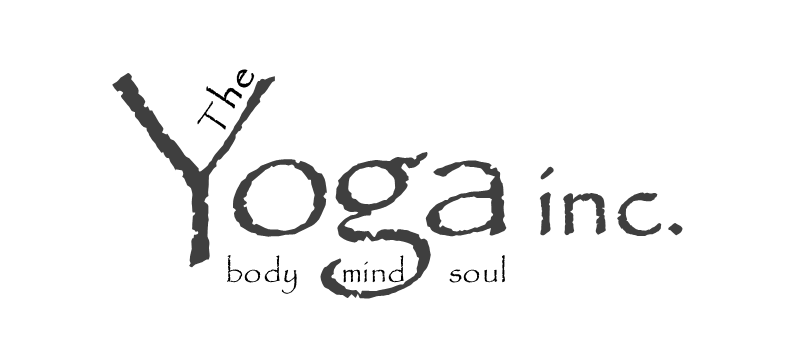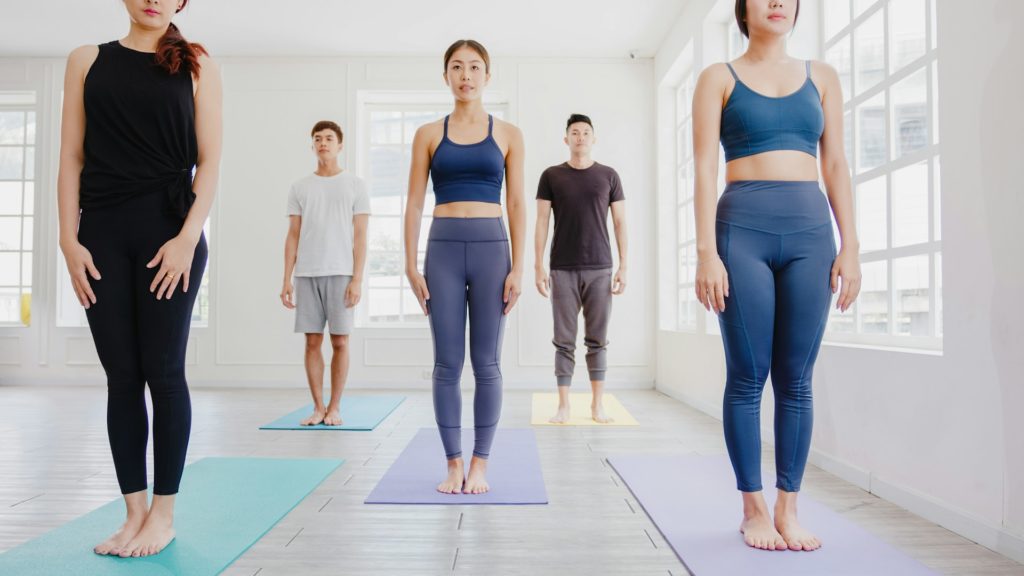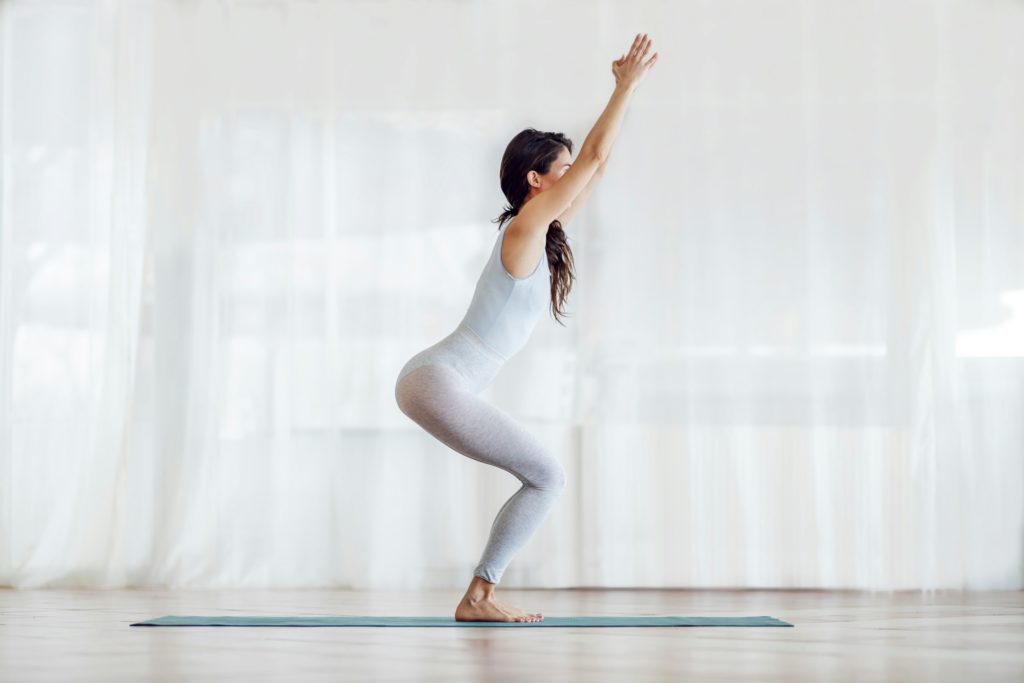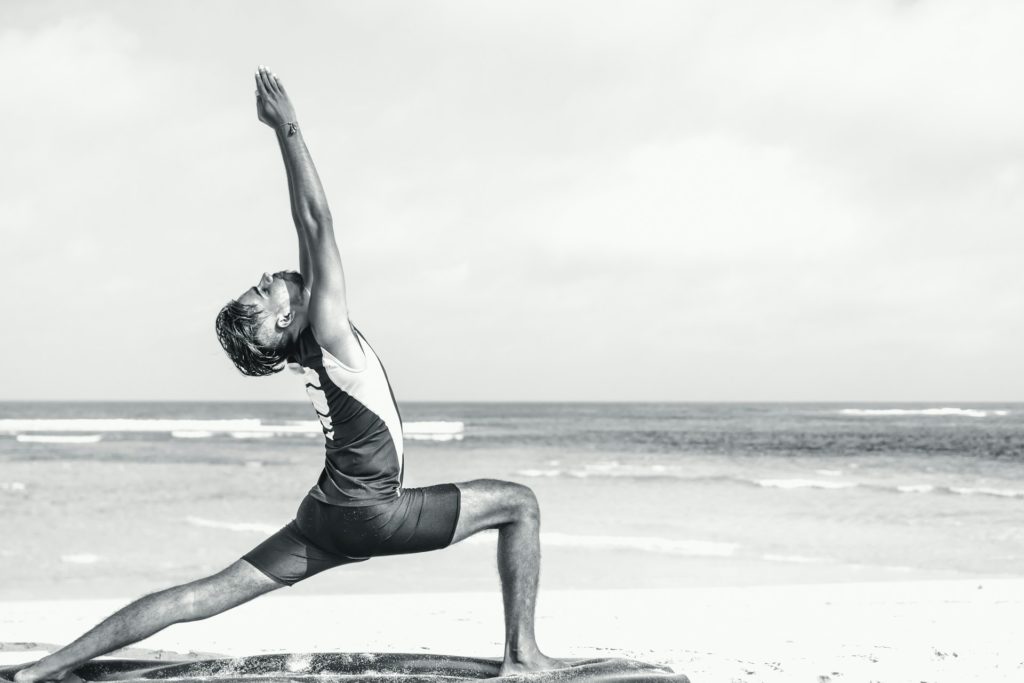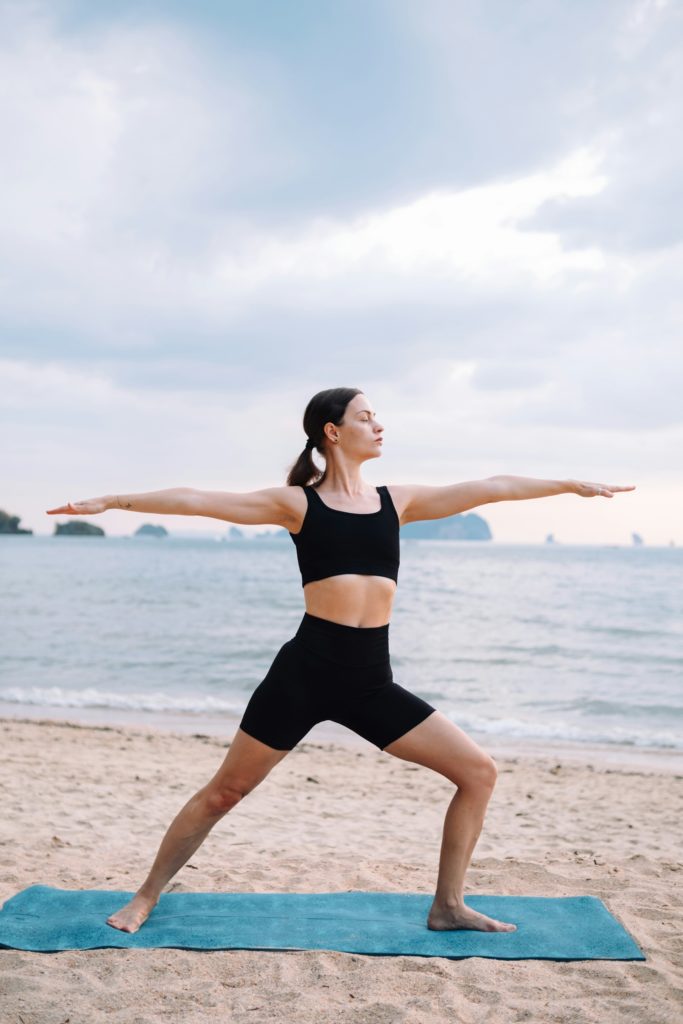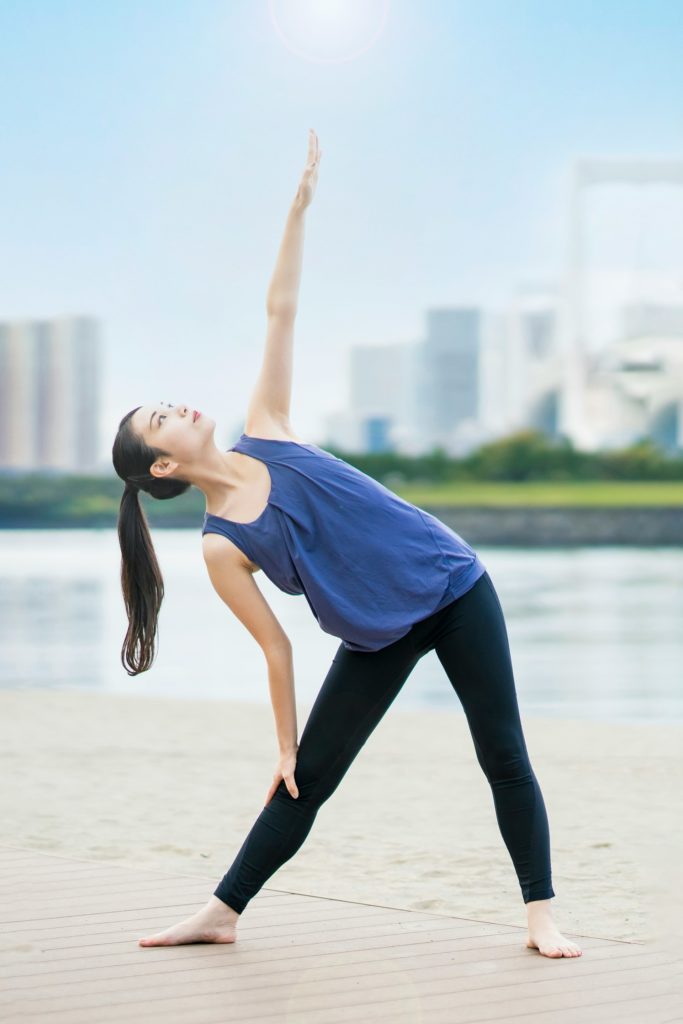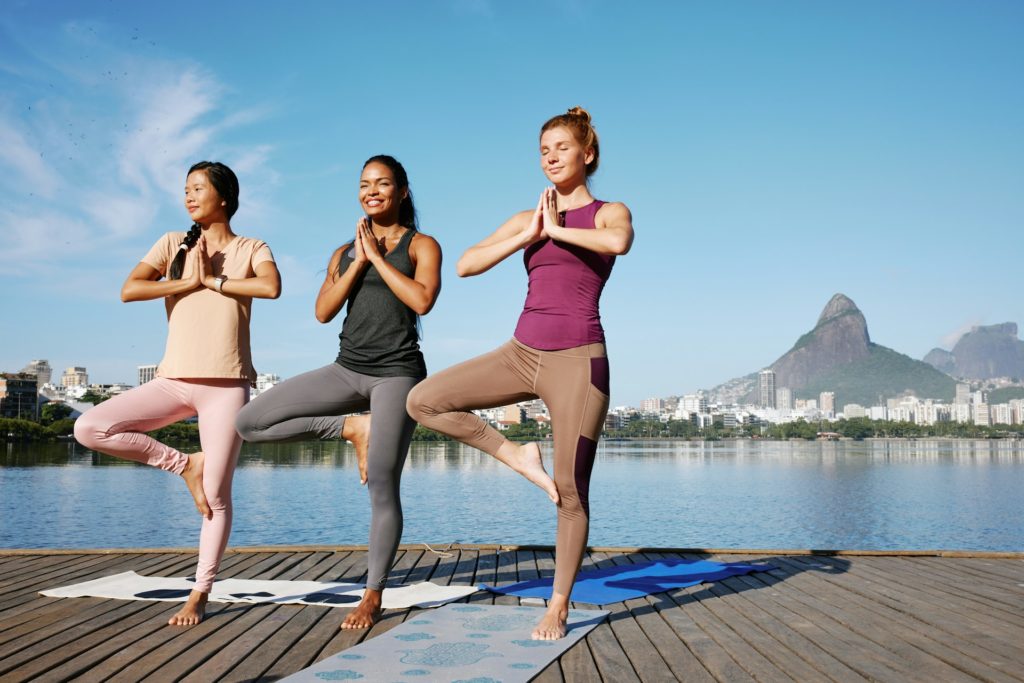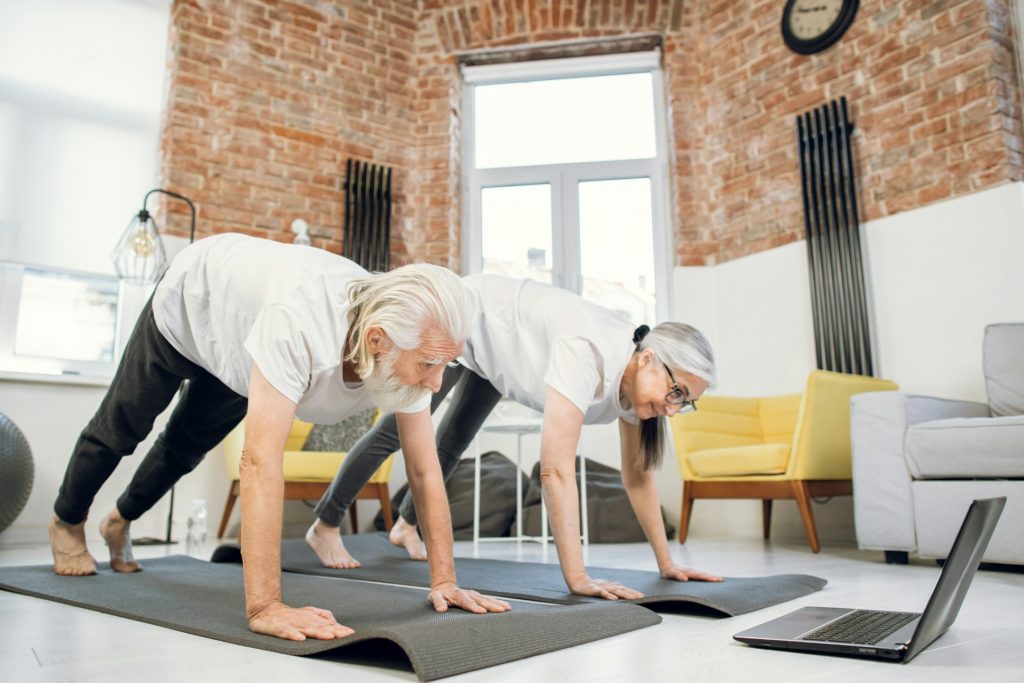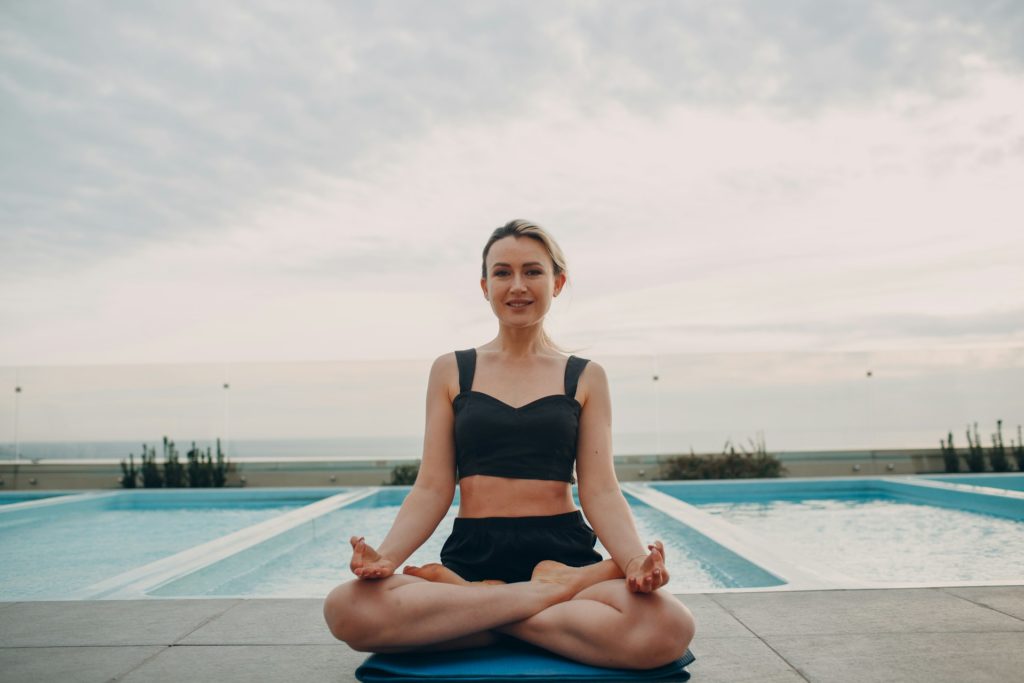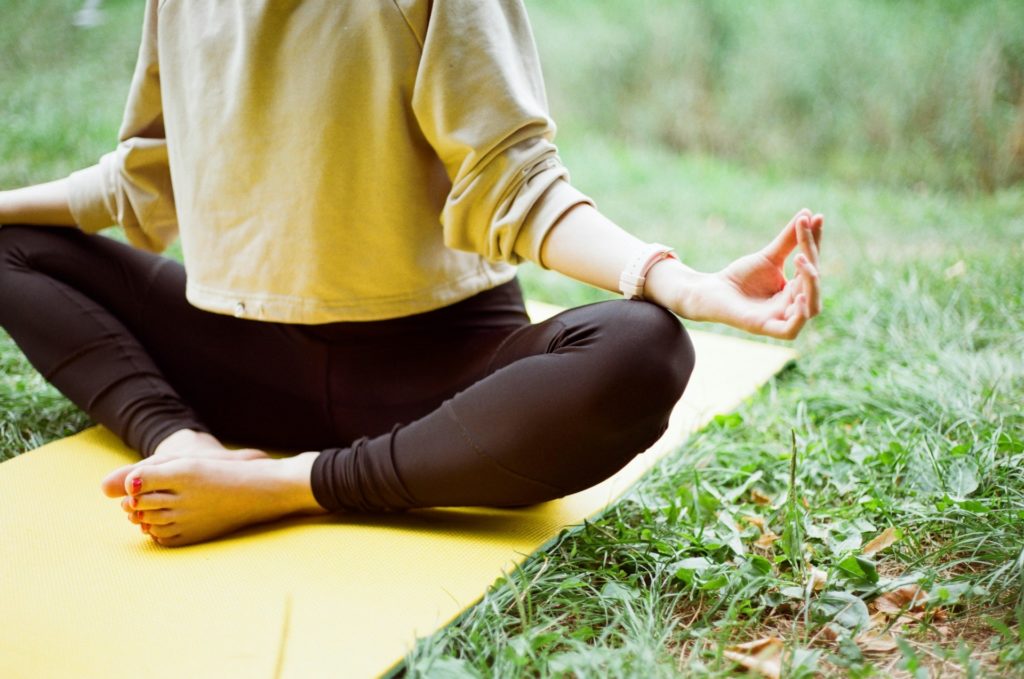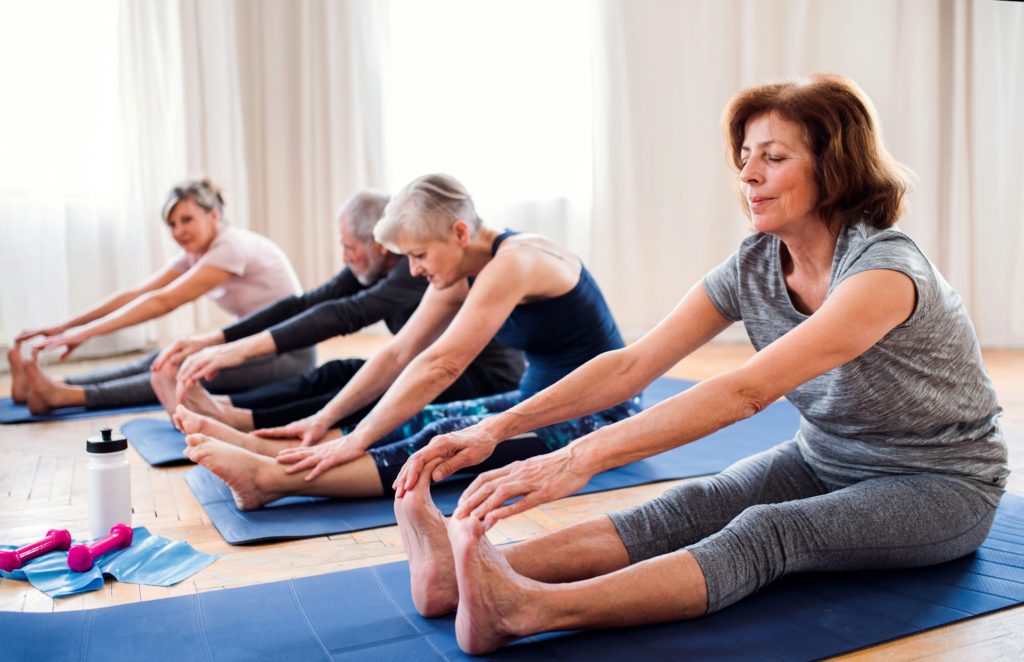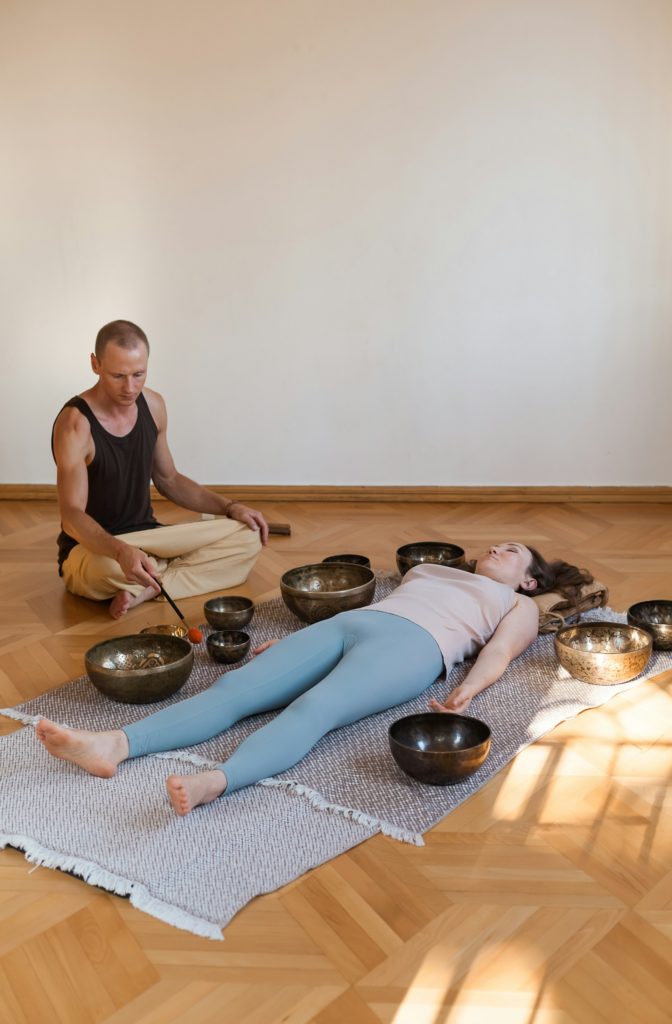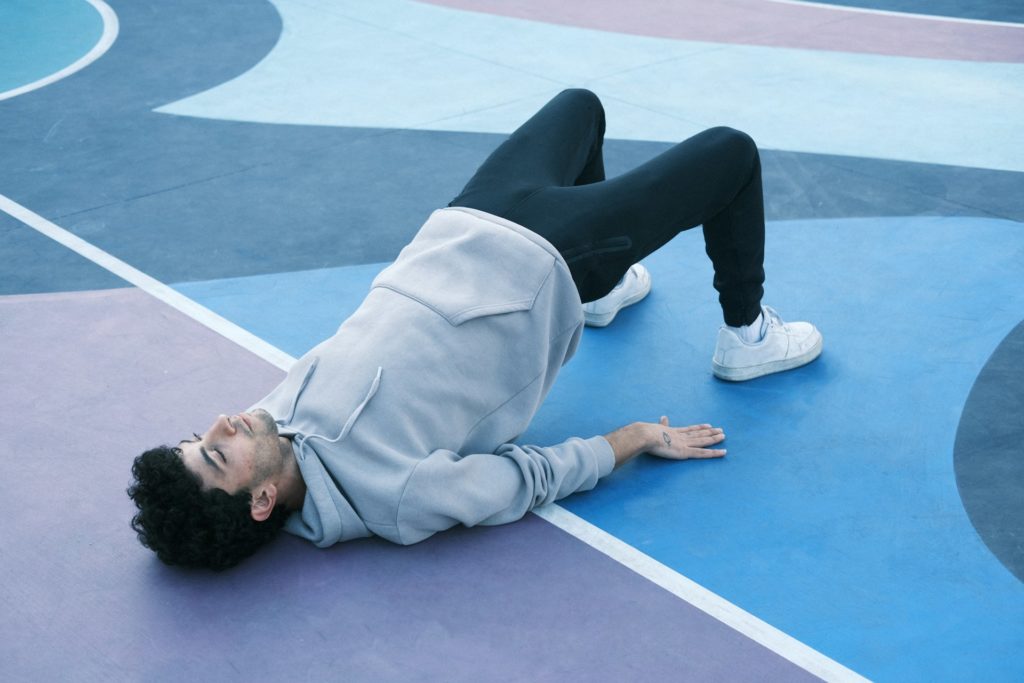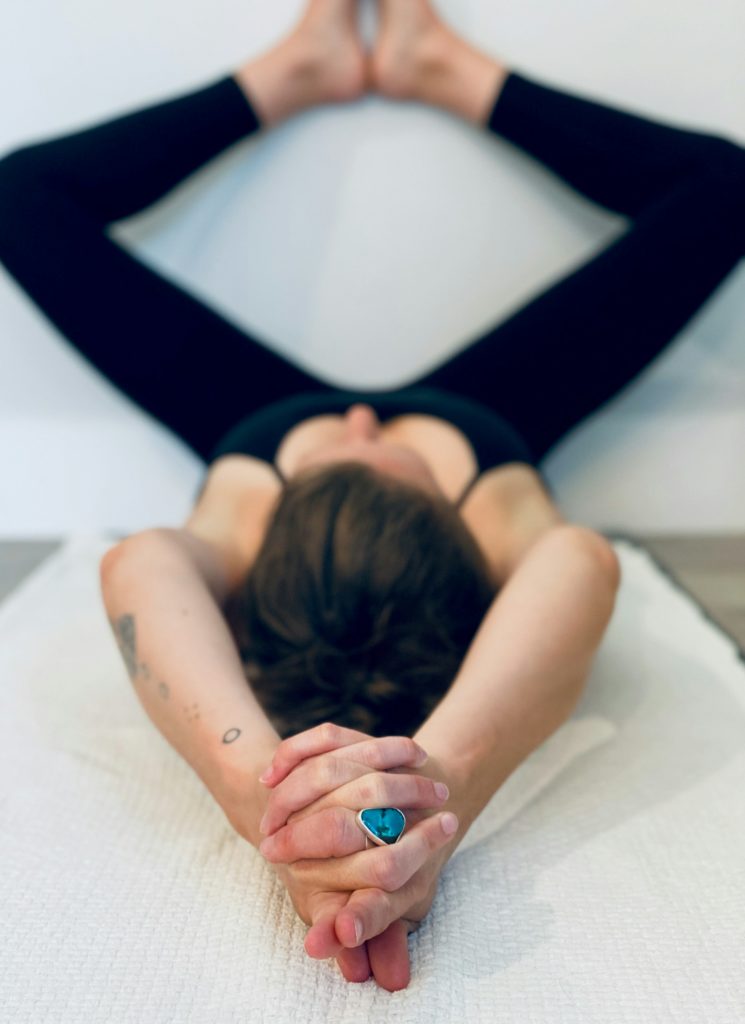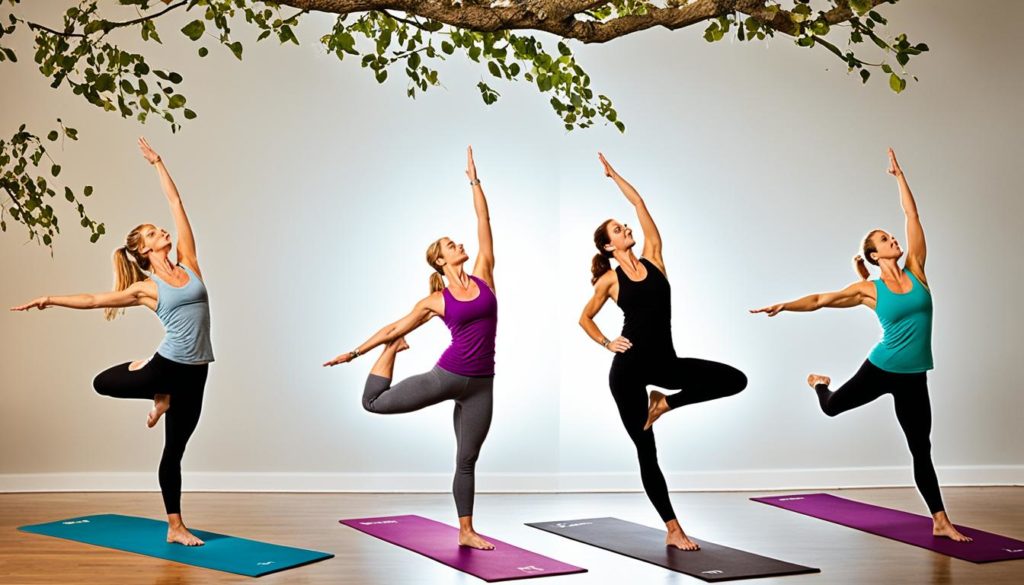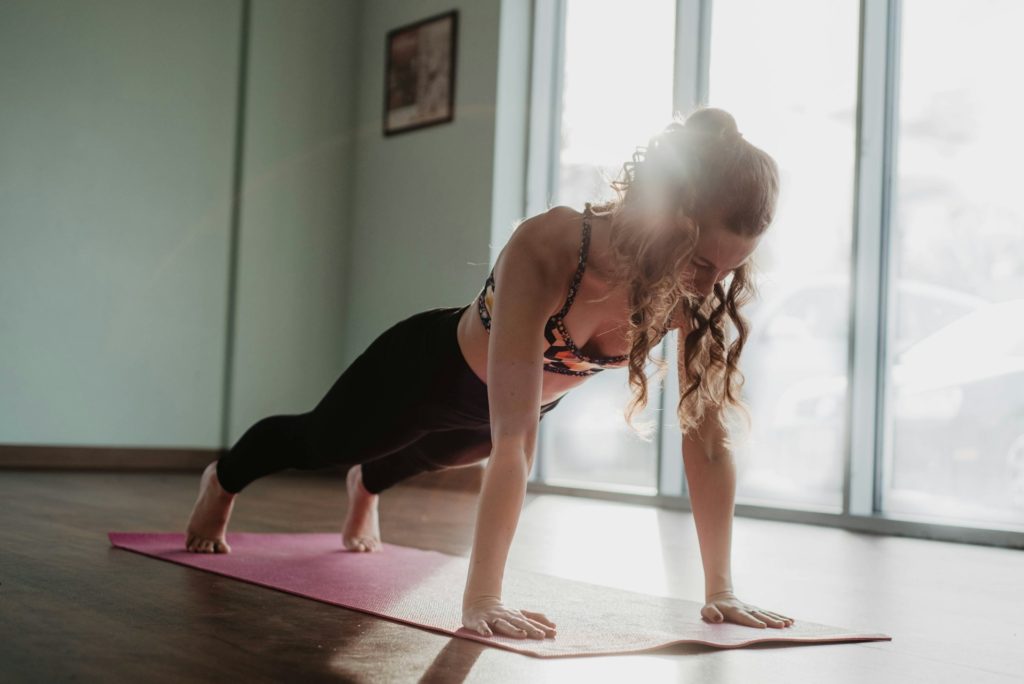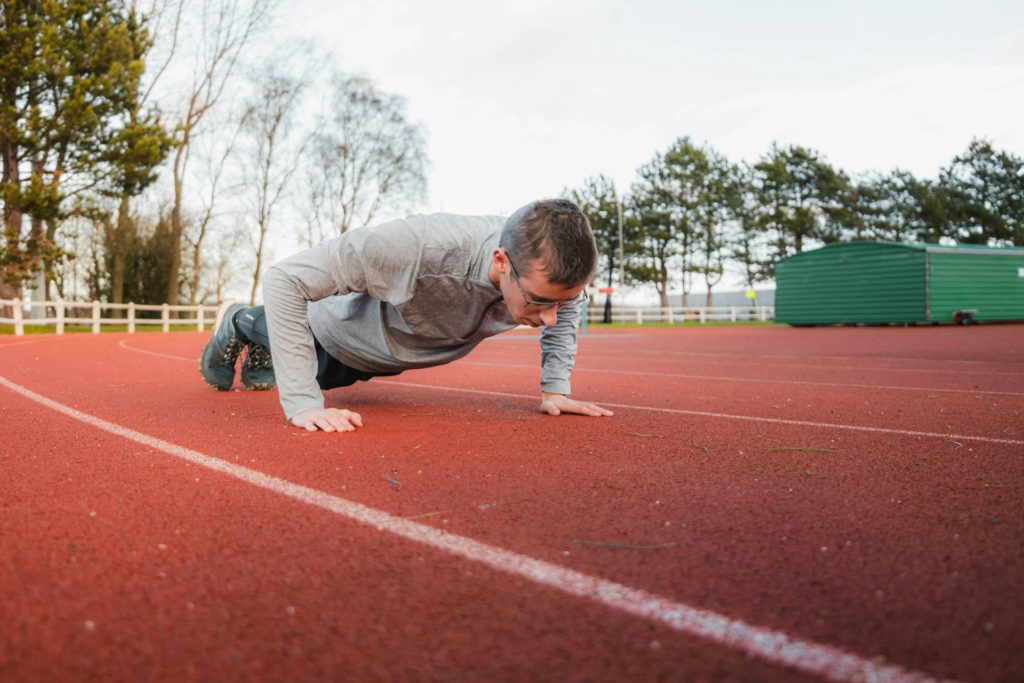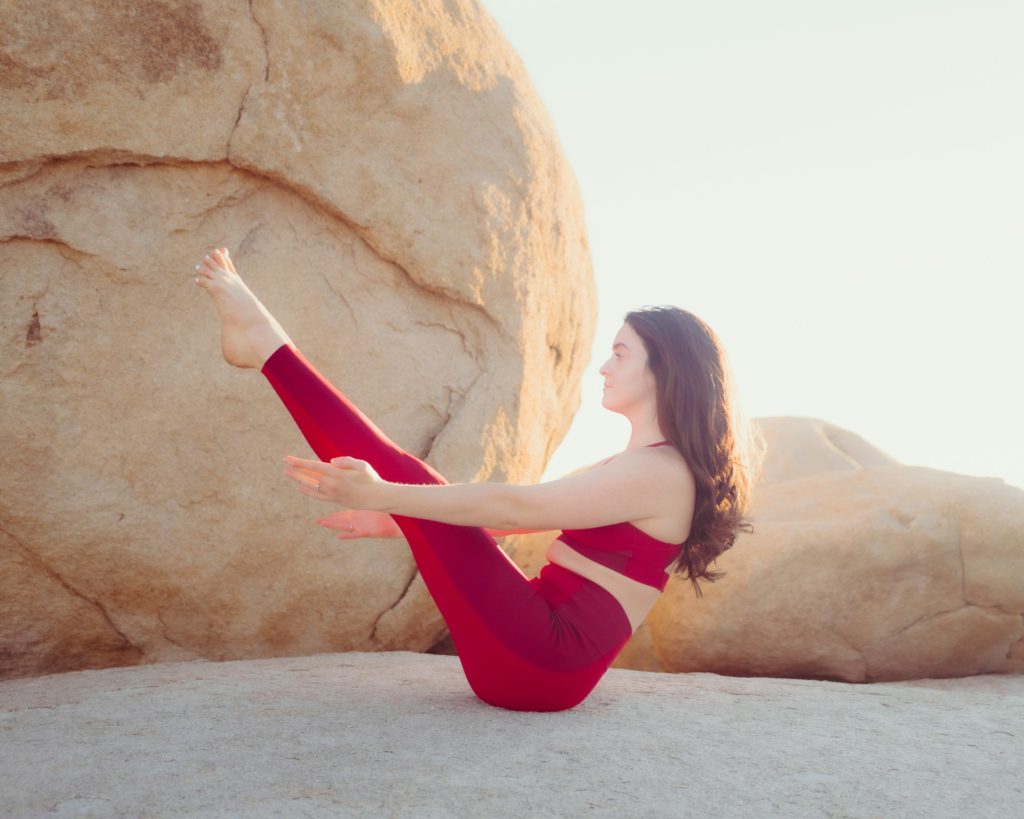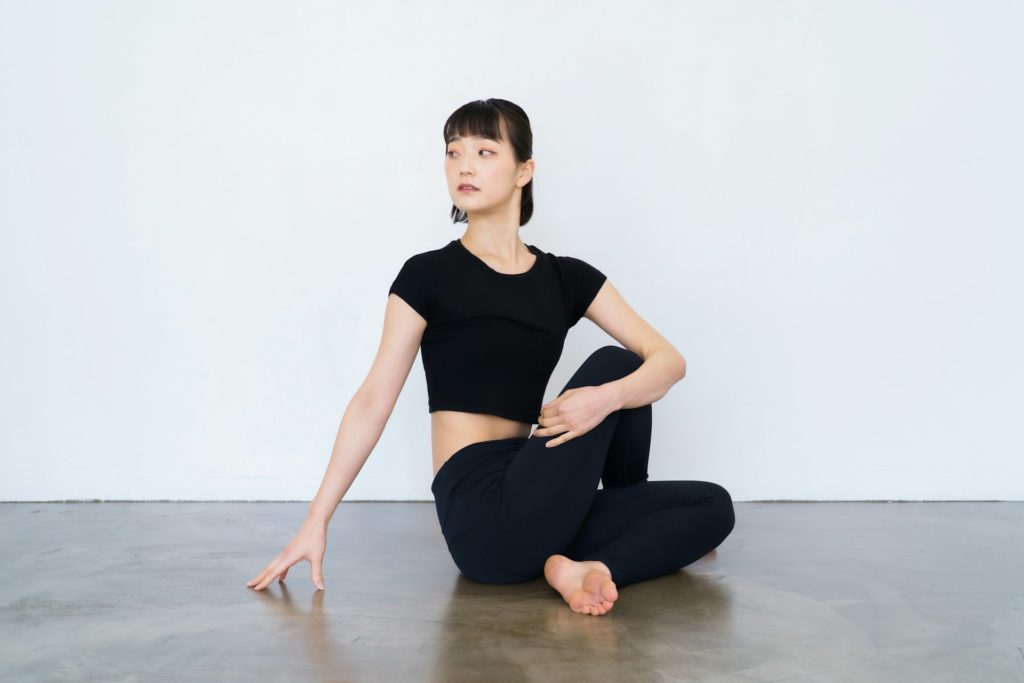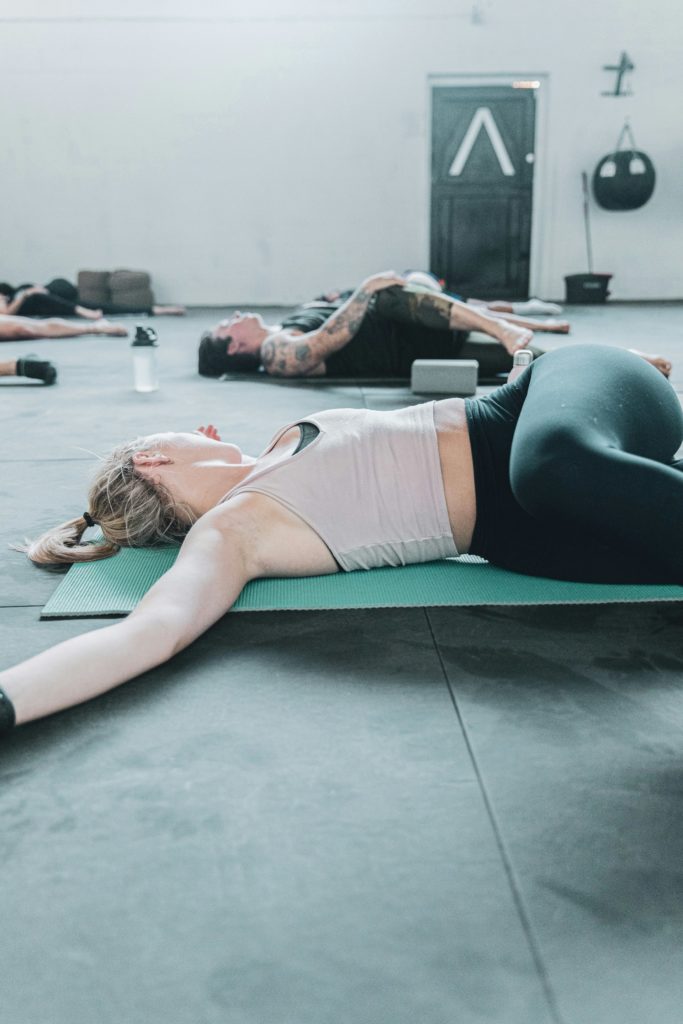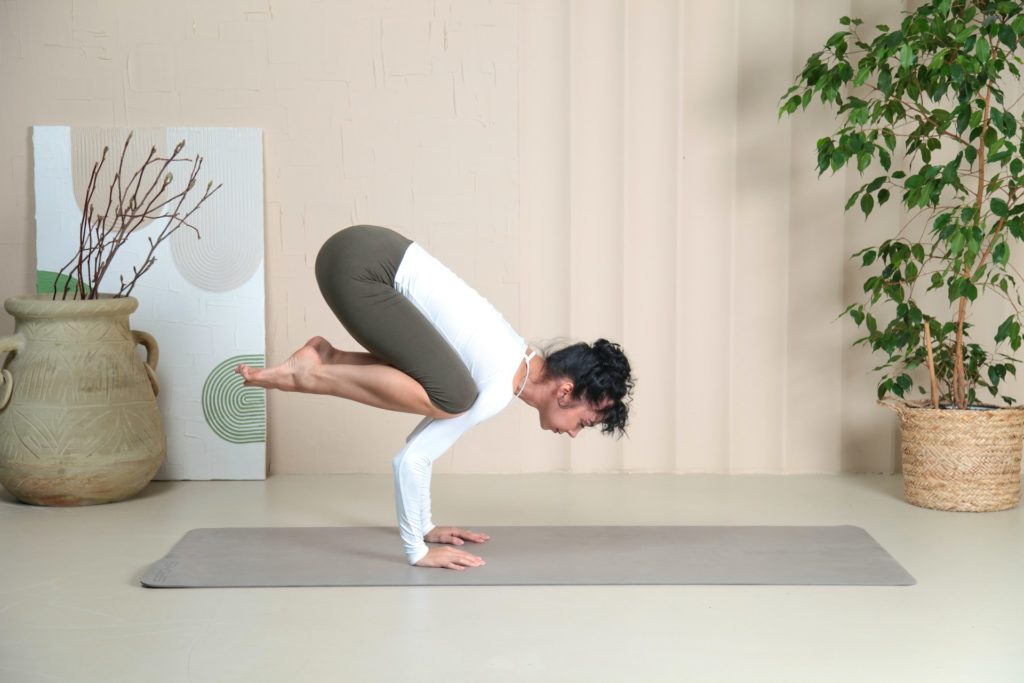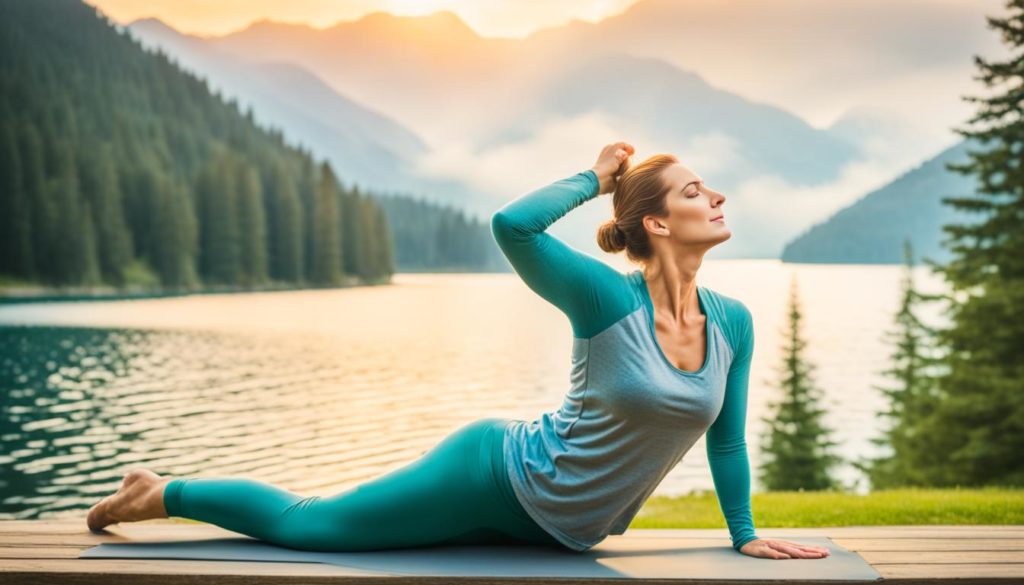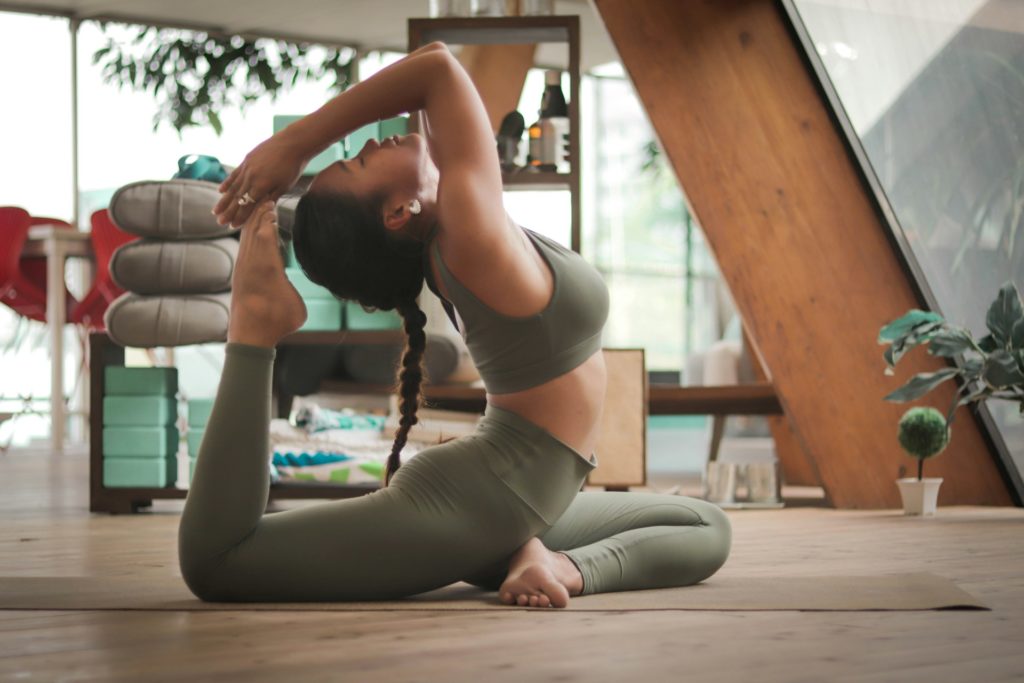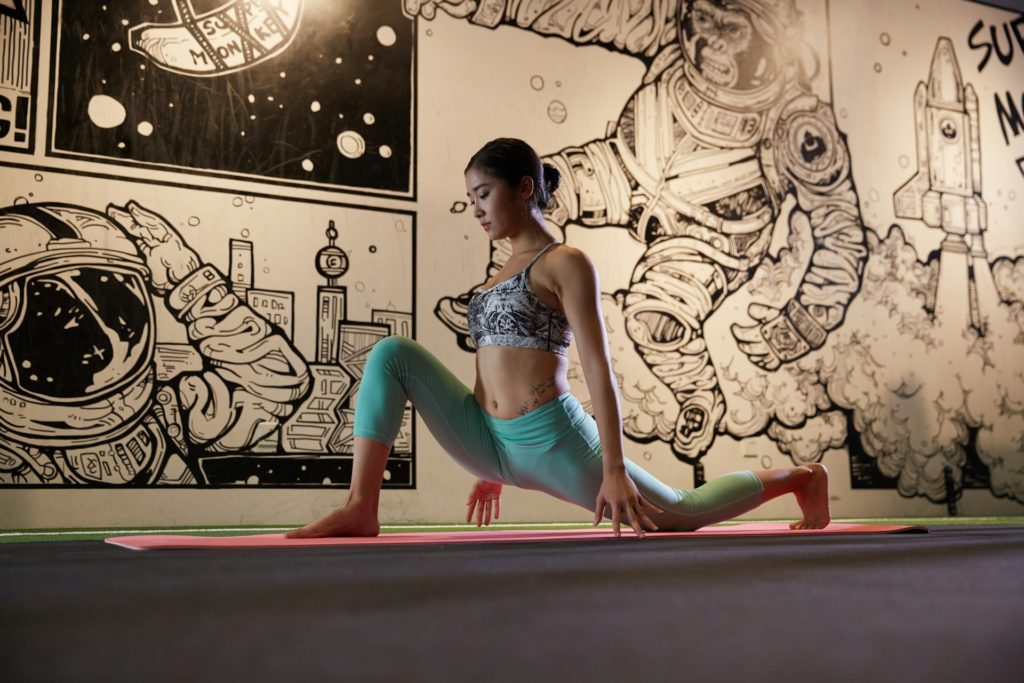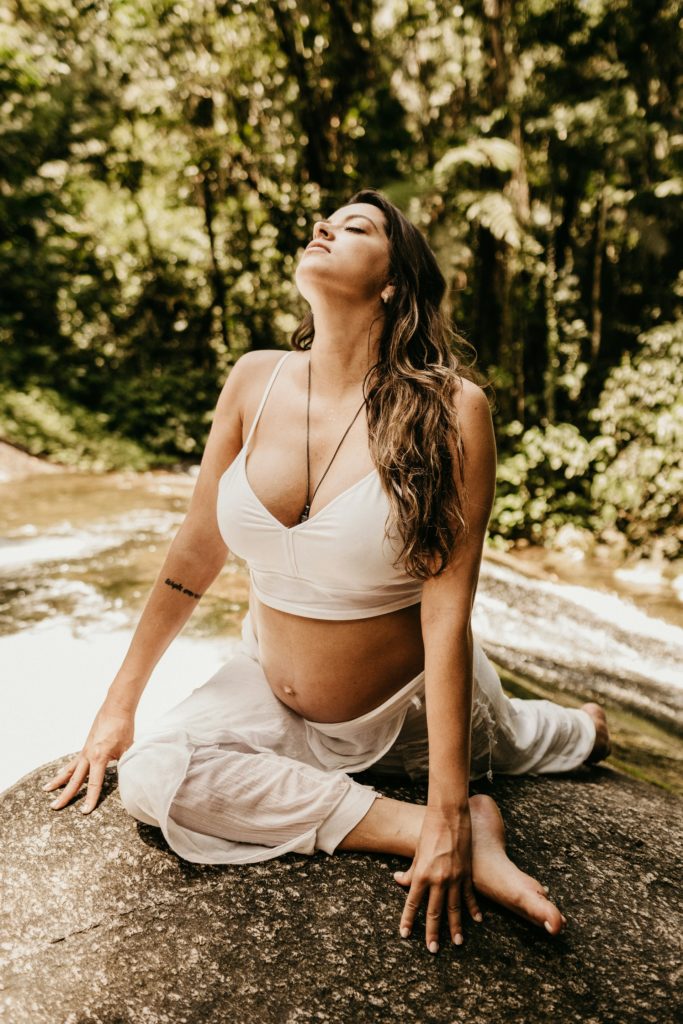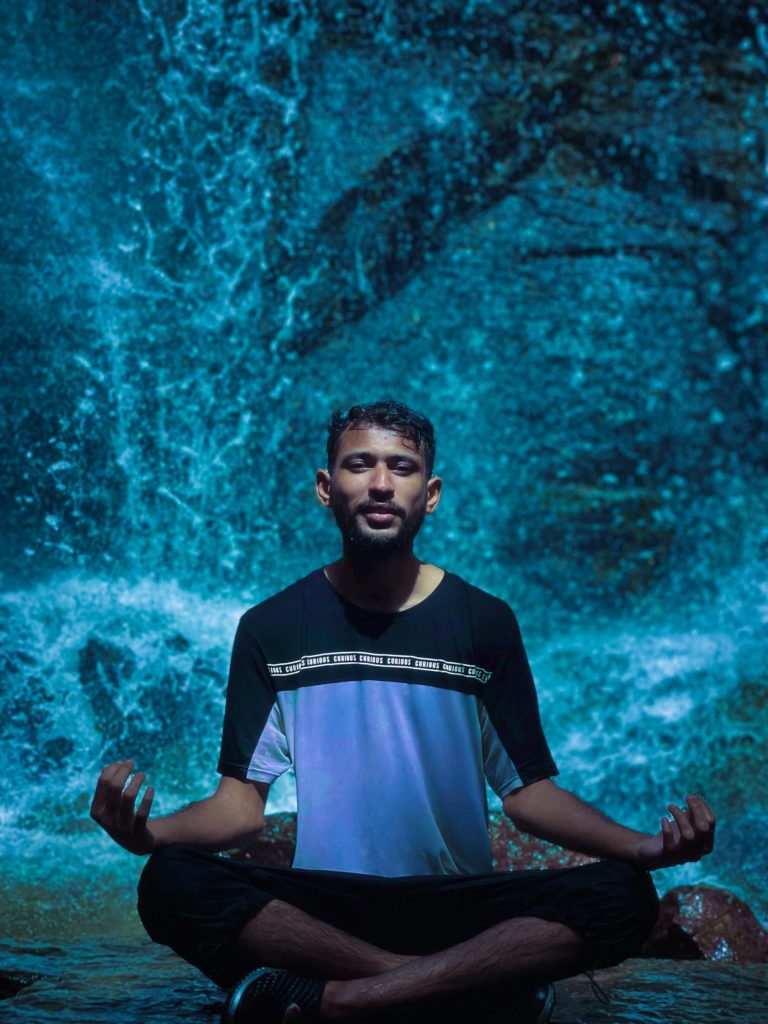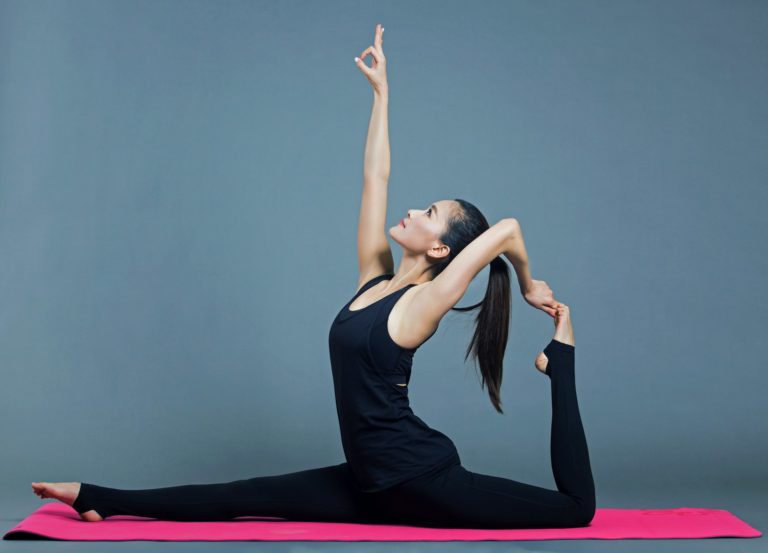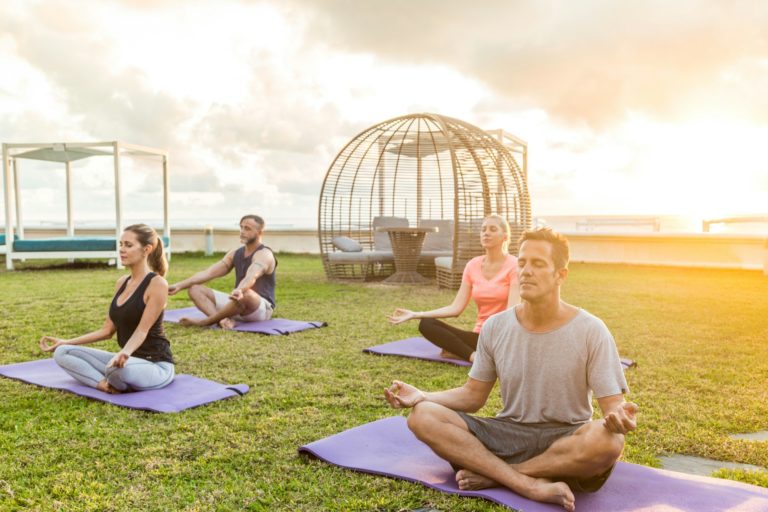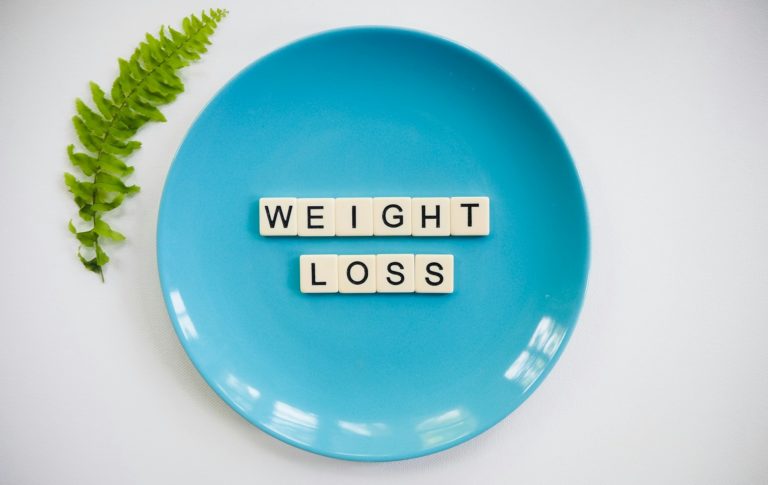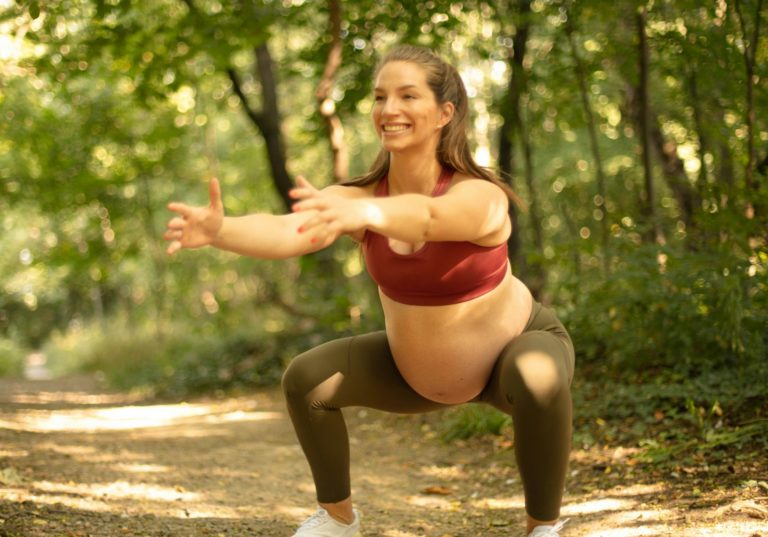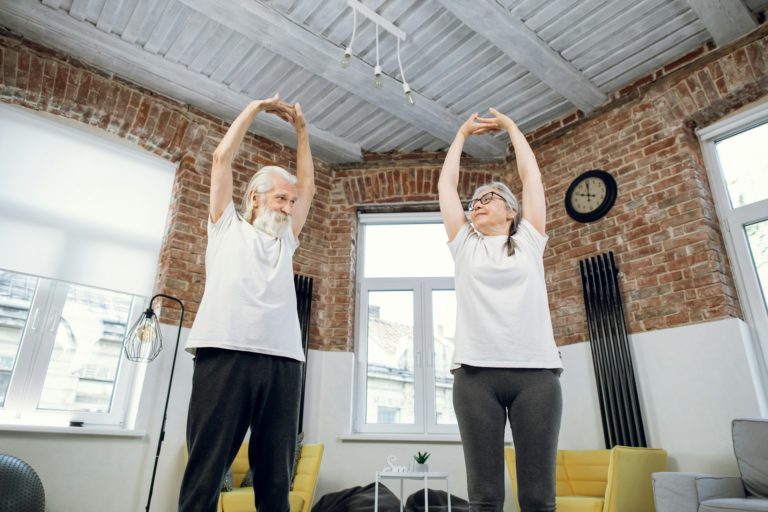Ready to step up your yoga game with Yoga Poses Names and Pictures? There are so many poses that it can be hard to know where to begin. In this blog post, I will show you more than 30 yoga poses, with their names and pictures. It’s perfect for beginners wanting to start strong or veteran yogis looking to improve their practice.
Yoga isn’t just about being flexible or balanced. It does wonders for our health, too. It fights anxiety, depression, and stress and lowers inflammation in our bodies. Yoga can even help make migraines not as bad. And let’s face it, doing a cool yoga pose feels incredible.
Now, I will introduce you to 30 simple yoga poses for beginners. I’ll tell you their Sanskrit and English names. You’ll learn standing poses like Mountain Pose and seated ones like Bound Angle Pose. Plus, you’ll see a few arm balances and inversions. And we’ve got tips from Chrissy Carter, a certified yoga pro, on how to do these poses safely and competently.
So grab your mat, breathe, and learn some yoga poses. By the end of this guide, you’ll be more sure and strong in your yoga and ready for all the great things yoga has to offer.
Key Takeaways
- Learn the names and pictures of 30 common yoga poses for beginners
- Discover the health benefits of practicing yoga, from reducing stress to improving flexibility
- Get tips from a certified yoga instructor on how to practice poses safely and effectively
- Explore different types of poses, including standing, seated, arm balances, and inversions
- Feel more confident and empowered in your yoga practice
Introduction to Yoga Poses
Yoga is becoming increasingly popular. This ancient practice is loved by A-listers and coworkers alike. It helps with many health issues, like stress and even migraines.
This guide will show you 30 easy poses. They are great for beginners. You will start strong and feel confident. Poses range from the simple Mountain Pose to the famous downward facing dog pose. Each pose brings unique benefits just for you.
What are Yoga Poses?
In the ancient language of yoga, “asana” means “seat.” It was a way to sit for meditation and to prepare the body for extended periods in a meditation pose. Patanjali, an Indian sage, said asanas help us focus and care for our bodies. He saw them as very important in yoga.
Now, “asana” means any physical pose in many types of yoga. You’ll see it in names like Trikonasana (Triangle Pose) and Utkatasana (Chair Pose). Almost all poses have “asana” at the end.
Benefits of Practicing Yoga Poses
Poses are great for your body and mind. They can do a lot for you:
- Improved flexibility and balance
- Increased strength, particularly in the legs, upper back, and shoulders
- Enhanced mental focus and clarity
- Reduced stress, anxiety, and fatigue
- Better circulation and energy levels
- Improved digestion and relaxation
A full-body stretch can also improve hip rotation, mobilize the spine, and enhance breathing and circulation.
No matter your goal, there’s a yoga pose for you. You might want to get stronger with poses like Warrior I or to relax with Child’s Pose. You’ll see how powerful these poses can be as you keep practicing. They can improve your daily life, inside and outside your yoga practice.
Standing Poses
Standing poses are vital to every practice. They strengthen us, help us balance, and make our bodies flexible. Doing these poses improves our posture, reduces our chances of injury, and makes us feel good. One such pose is the standing forward bend, which stimulates digestion, improves blood circulation, and stretches various muscles.
Mountain Pose (Tadasana)
Mountain Pose, or Tadasana, is where all standing poses start. It seems easy, but you need to focus on doing it right. Keep feet hip-width apart, legs and core tight, and arms at your sides. This pose is good for posture, balancing, and understanding your body better.
Chair Pose (Utkatasana)
Chair Pose, or Utkatasana, is excellent for strengthening our legs, arms, and core. Start from Mountain Pose. Bend your knees, lower like sitting in a chair, and lift your arms up. Stay like this for a few breaths, then return to Mountain Pose.
Warrior I Pose (Virabhadrasana I)
Warrior I Pose, or Virabhadrasana I, is a stretch for the hips, chest, and lungs. It also strengthens our legs, arms, and back. Step your left foot back and bend your right knee, keeping it over your ankle. Your arms go up, looking straight. Hold, then change sides.
Warrior II Pose (Virabhadrasana II)
Warrior II Pose, or Virabhadrasana II, is good for the legs, hips, and balance. Step far apart, with the right foot out and the left foot slightly in. Bend your right knee over the ankle, arms out. Stay a few breaths, then switch sides.
Triangle Pose (Trikonasana)
Triangle Pose, or Trikonasana, is a stretch for the legs, hips, and spine. It strengthens the core and helps with balance. Step wide, right foot out, left foot in slightly. Reach your right hand down and left arm up. Keep core tight. After a few breaths, switch sides.
Tree Pose (Vrksasana)
Tree Pose, or Vrksasana, is all about balance. It involves focusing on the standing leg to maintain stability and improve focus and balance. Start from Mountain Pose. Put your right foot on the inner left thigh or calf, but don’t let it touch your knee. Hold hands together at heart. Hold, then switch sides.
Doing these daily poses helps you become strong, flexible, and balanced. Always listen to your body. Use help, such as props, if you need it.
Downward-Facing Dog (Uttana shishosana)
Downward-facing dog is a popular yoga asana (posture) that stretches hamstrings, opens shoulders, and elongates the spine. It’s a basic pose, and many sequences utilize it. Traditional Downward-Facing Dog is challenging to do, especially for yoga newbies or those with weak upper bodies.
This is where the modified version of this asana, Downward-Facing Dog on Chair (Uttana shishosana), can help. This yoga asana modification offers the same rewards as traditional downward facing dog poses. It eases the pressure of weight on your upper body, making it easier for yoga beginners to perform.
To do Downward Facing Dog on a Chair, follow these steps:
- Position a stable chair against a wall with the chair’s backrest towards you.
- Turn around to face the chair several feet away from you.
- Position your hands on the chair’s backrest, arms straight and shoulder width apart.
- Step your feet backward, forming a 90-degree angle between your body and the ground.
- Hold your hands firmly on the chair with straight arms.
- Press your chest towards your thighs and elongate your spine.
- Activate your core and take steady, deep breaths here.
Performing Downward-Facing Dog on a Chair allows you to focus on stretching the hamstrings, opening the shoulders, and elongating your spine without placing excessive weight on your upper body. This modified pose is excellent for beginners or those with limited upper body strength. You can still experience the benefits of Downward-Facing Dog.
Balancing Poses
I’ve learned that balancing poses are essential for strong cores and stable minds. These poses help you stay steady on one leg or your hands. They make your body find balance in both simple and challenging ways.
The Extended Side Angle Pose (Utthita Parsvakonasana) is another excellent balancing pose. It energizes the body and develops stamina while emphasizing proper form and alignment to maximize benefits.
Tree Pose (Vrksasana) is my top pick because it strengthens my legs and core. First, put your weight on one foot. Then, place the other foot on your inner thigh or calf. Stare at a still point to stay steady and tighten your belly.
Warrior III (Virabhadrasana III) is also great. It works your legs, ankles, and core. Start in a high lunge, then bend forward over your front leg as you lift your back leg. Reach your arms ahead and take a deep belly breath. It’s hard but boosts your strength, focus, and balance in yoga. Learning balancing poses changed the game for me. It’s not just my yoga that’s better. In things like climbing rocks and sailing, I’m more stable and clear-minded because of these poses. They make me face new stuff and do well in it. When you try balancing poses, remember it’s all about your path. It’s OK to tip or slip; use it to improve. Keep at it; your balance, strength, and belief grow.
No matter your skill in yoga, adding balancing poses is fantastic. They’re suitable for how you feel and think. So, be up for the challenge, keep your eye on the prize, and enjoy the journey into balancing yoga poses!
Seated Poses
Seated poses are great for increasing flexibility, improving posture, and feeling calm. You can do simple poses like sitting with your legs crossed or try harder ones to work on your hips, legs, and spine. Including these poses in your routine can benefit your body and mind. Additionally, incorporating knee poses such as Head-to-Knee Pose and Revolved Head-to-Knee Pose can stretch the hamstrings, calm the mind, and improve digestion.
Seated poses are fantastic for stretching your leg muscles. They help make your hamstrings, quadriceps, and calves more flexible. Moves like Seated Forward Fold and Bound Angle Poses are perfect for this. Seated poses also make your legs more stretchy and less tight, and they make your hips feel less tense.
These poses are good for improving your posture. Poses like Staff Pose and Easy Pose help your spine stay straight and your chest open. They also make you aware of how you sit and stand. You might find your back hurts less, and you get hurt less. Plus, it makes you feel better in general.
Easy Pose (Sukhasana)
Easy pose is a basic way of sitting that’s good for meditating. You sit comfortably on the floor with your legs crossed, which helps your hips get more open and gives you a solid feeling. It’s an excellent start for anyone new to yoga.
Bound Angle Pose (Baddha Konasana)
Bound Angle Pose works your inner thighs and groin. You sit and bring your feet together, knees falling to the sides. Hold your feet and press your legs down with your elbows. It makes your hips more open, which is good for digestion and health.
Seated Forward Bend (Paschimottanasana)
Seated Forward Bend stretches your back and legs. You sit with your legs in front, feet flexed. Inhale and exhale as you reach forward, trying to touch your toes. If your legs are tight, use a strap. This pose is also very relaxing and can relieve stress.
Listen to your body when you do these poses. Stop and maybe use a cushion or block to help if something hurts. With time and practice, Seated Forward Bend poses can make you much more flexible, mindful, and peaceful.
Supine Poses
Supine poses help you relax and find balance. They are great for opening your hips and easing tired legs. They also allow you to slow down and focus on your breathing. Additionally, supine poses provide a full-body stretch, benefiting the spine, hips, legs, glutes, and abdominal muscles.
Supine poses can be held longer than others. For strength poses, hold them for 4-6 breaths. Stretching poses should be held for 6-12 breaths, which lets your body relax and deepen the stretch.
Supine poses cater to many needs. Happy Baby Pose is for gentle stretches. Supine Eagle Twist is for those who want a challenge. All these poses offer relaxation, flexibility, and many more health benefits.
Corpse Pose (Savasana)
Most yoga classes or sessions end with Corpse Pose (savasana), which relaxes the whole body and mind. To do it, lie down and focus on your breathing. This posture helps you feel at peace.
Bridge Pose (Setu Bandha Sarvangasana)
The Bridge Pose energizes and stretches your body. It helps calm your mind and improves digestion. To do it right, keep a block between your thighs to align your knees properly.
Reclined Bound Angle Pose (Supta Baddha Konasana)
Reclined Bound Angle Pose is good for your hips. Lie down with the soles of your feet together. Let your knees fall to the sides for a hip stretch. Focus on your breathing to relax.
Adding these supine poses to your practice has many benefits. They can help you relax, feel flexible, and heal. It’s a great way to take care of your body and mind.
Yoga Poses Names with Pictures
Yoga is super popular now. Everyone, from celebs to my coworkers, is doing it. It’s great for your health. It fights anxiety and depression and lowers stress and inflammation, and yoga is fantastic for weight loss. But let’s admit it: yoga names can be tricky. They sound like Harry Potter spells. How can I twist into Utkatasana? The upward facing dog pose, also known as Urdhva Mukha Svanasana, is a powerful pose for upper-body strength and an excellent stretch for the chest and abdomen.
No worries, fellow yogis! I’ve made a guide for you. It has 30 common poses in Sanskrit and English. Whether you’re just starting or you’ve been at it for a while, this guide will help. You’ll know a lot more and impress your friends with Sanskrit words!
Visual Guide to Common Yoga Poses
This guide includes pictures of each pose. You’ll see classic ones like Tadasana and Adho Mukha Svanasana and more advanced ones like Virabhadrasana II and Trikonasana. I’ve added my favorites, like Vrksasana for balance and Savasana for deep peace.
Detailed instructions for each pose help you do them right and avoid getting hurt. You’ll also learn the benefits of each pose, like better flexibility and stress relief. Get ready to feel the positive changes in your body and mind. You’ll enjoy these poses!
Sanskrit Names and English Translations
Yoga’s history and culture are unique. That’s why knowing the Sanskrit names is cool. In this guide, you get both Sanskrit and English names.
You don’t need to be a Sanskrit expert. I’ll help you with pronunciations and meanings. For instance, did you know Utkatasana means “fierce seat”? And Balasana is “Child’s Pose”? Knowing this makes your yoga practice deeper.
In the end, yoga is about joining mind, body, and spirit. Try these 30 poses. Their names in Sanskrit and English will guide you. With practice, you’ll see how influential yoga is. Enjoy your journey!
Core Strengthening Poses
Yoga has many poses that strengthen your core. These poses focus on your stomach, sides, and lower back. They keep you steady, help posture, and prepare you for more challenging poses. Practice a few poses often, and you’ll be ready for more.
Plank Pose (Phalakasana)
Plank Pose works your whole body. Start in a push-up pose. Your hands should be under your shoulders, and your feet should be apart. Your core should be tight, making a straight line from head to heels. Hold it for 15 to 30 seconds.
Four-Limbed Staff Pose (Chaturanga Dandasana)
Chaturanga helps the arms, shoulders, and core. Start from a Plank and lower down. Your elbows should make a 90-degree angle close to your body. Keep your core strong and hold for five breaths. Then, lower or push back up to the Plank.
Boat Pose (Navasana)
Boat Pose is excellent for deep abs and balance. Sit with knees bent and feet on the floor. Lean back and lift your feet. Straighten your legs and reach your arms forward. Hold for 10 to 20 breaths.
Add these poses to your routine to build core strength. They prepare you for more challenging poses. Use props if you need to. You’ll see a stronger core and many yoga benefits with time and effort.
Backbend Poses
Backbends are a group of poses that bend your spine backward, forming an arch. They stretch and strengthen your spine, open your chest and hips, and make you feel alive. There are backbend poses for every level, from easy to hard.
Bridge Pose is a step to bigger backbends and helps you focus. Kapotasana, or Pigeon Pose, energizes you and lifts your mood. Natarajasana, or Lord of the Dance Pose, needs balance, flexibility, and focus. You can perform it with interest.
Each backbend has its perks. Some gently extend your spine, while others strengthen your back and core. They all help your body move better and become more aware of itself.
Listening to your body is vital in backbends. Keep your neck steady and exit poses carefully to avoid hurting yourself. Depending on your flexibility and strength, there’s a backbend for everyone, from newbies to pros.
Embrace the journey of exploring backbend poses, and let your practice unfold with patience, curiosity, and joy.
Twisting Poses
Twisting poses are critical to a good practice. They help the spine become more flexible, aid in better digestion, and strengthen stomach muscles. These moves can also lower back pain and help fight stress. Remember, breathing right is a big deal when doing twist poses. It helps keep your rib cage from feeling cramped.
There’s a wide range of twist poses, over 450 to choose from. You might start with gentle seated twists or try more tough standing twists. Like Deer Pose, seated twists hit deep tissues, which is excellent for Yin Yoga. Standing twists are good for balance but might need props. Doing twists makes your spine, hips, shoulders, and core more flexible.
Seated Spinal Twist (Ardha Matsyendrasana)
Seated Spinal Twist is a well-known pose. It’s great for a deep spine and side stretch. Sit with your legs straight out, then bend your right knee over the left leg. Place your right hand on the floor behind you. Hook your left elbow on your right knee. Inhale, lengthen your spine. Exhale, twist your torso right. Hold, then do the other side.
Supine Spinal Twist (Supta Matsyendrasana)
A Supine Spinal Twist is a gentle move for all levels. Lie on your back with your knees up and feet on the floor. Stretch your arms to the sides, palms up. Breathe out. Drop your knees right, but keep your shoulders down. Look over to your left hand. Hold, then switch sides.
Most people can do twists safely, but check what feels right for you. Skip any twists that hurt. Talk to a yoga pro first if your back’s been hurt or hurts often. Twists are great for many things: a more flexible body, better digestion, and feeling less stress.
Let’s keep twisting in our yoga for all these good reasons.
Restorative Poses
Restorative poses help you unwind and relax after a long day. They focus on releasing tension, stretching tight muscles, and healing from stress. There are over 1100 poses to choose from, including standing, seated, and lying down.
Restorative yoga boosts your natural energy. A quick 10-minute session can make you feel more refreshed than coffee. Heart opener poses, such as Supta Baddha Konasana, help reduce stress and benefit your heart and circulation.
Restorative twists like Gomukhasana are great for calming down and improving digestion. Inversions, like Legs Up the Wall, help relax, improve blood movements, and calm the mind.
Restorative poses are held for 5 to 25 minutes. This lets the body fully relax and let go of tension.
They don’t just help your body; they also suit different health needs. The side-lying Pose rests the nervous system, and the Reclined Half Moon Pose suits your spine and lymph system. Malasana opens the hips gently at a wall, helping digestion without knee strain.
A good session includes 4-6 poses, ending with Savasana. Savasana lets your body recharge and refresh; absorbing hydration makes you feel renewed.
Adding restorative yoga to your routine boosts blood flow, organ health, and flexibility. It strengthens your body and reduces stress, making you feel better. So, when you need a break or self-care, try healing restorative yoga.
Arm Balance Poses
Arm balances in yoga are dynamic and challenging. They require upper body strength, a solid core, and focus. Balancing a lot of your weight on your hands or forearms can make you more confident and open up new parts of your yoga.
One famous arm balance is Crane Pose (Bakasana). It’s great for beginners and focuses on balance more than shoulder strength. To do Crane Pose, get into a low squat with your hands on the ground. Then, use your core to lean forward. Lift your feet off the ground and balance on your arms with your knees on your triceps.
Another well-known one is the Side Plank Pose (Vasisthasana). It works your shoulders, core, and legs. From Downward Dog, put your weight on one hand and stack your feet. Lift your other hand. Keep your hips up and your body straight from head to heels.
Crow Pose and Crane Pose tone the abs and the arms, strengthening the core.
If you want to try more challenging poses, there are many, like the Eight Angle Pose, Firefly Pose, and Forearm Stand. These poses require more flexibility, strength, and balance. But they can be fulfilling when you practice with patience and good form.
Remember, practice is the way to improve arm balance. Start with simple poses, like Plank and Downward Dog, to get stronger. Then, move on to more challenging poses. With hard work and an open mind, you’ll improve your arm balances step by step!
Hip Opening Poses
I love yoga and have found that doing hip openers daily has fantastic benefits. These poses help to stretch the hips and nearby muscles, making you more flexible, improving movement, and boosting blood flow in your legs.
Adding these poses to your routine can reduce back pain and even change your emotional feelings. They release stress in your hips.
Tight hips can make your whole body feel stiff. Shortening of the psoas muscle can lead to a tight lower back. The hips are essential for body balance, flexible movement, and staying steady.
The root chakra in your pelvis is linked to sensual feelings, creativity, and openness. Hip-opening yoga helps you connect with these energies and brings a sense of liveliness and openness.
It’s important to push yourself gently when doing hip openers. Each pose should be held for 10 seconds, letting your muscles relax and stretch. Over time, you can aim for 30 seconds in each pose for maximum benefit.
Pigeon Pose (Eka Pada Rajakapotasana)
Pigeon Pose is excellent for opening the hips. It deeply stretches your hip rotators, glutes, and flexors. This posture can be challenging, but it feels perfect.
To do this pose, begin on all fours. Bring your right knee forward to your right wrist. Straighten your left leg back, keeping your hips level. Inhale, lengthen your spine. Then, as you exhale, bend over your right leg, resting your head on a mat or block.
Lizard Pose (Utthan Pristhasana)
Lizard Pose is another fantastic hip opener. It works the hip flexors, quads, and inner thighs. From Downward-Facing Dog, step your right foot forward to the outside of your right hand. Lower your left knee and push your left foot back, keeping your hips straight.
You can stretch further by lowering your forearms, which gives your hips and legs a deeper stretch.
Half Pigeon Pose (Ardha Kapotasana)
Half Pigeon Pose is a softer form of Pigeon Pose, perfect for starters. Start in Downward-Facing Dog. Bring your right knee forward and set it behind your right wrist. Stretch your left leg back, keeping your hips even.
Then, walk your hands out and lean over your leg. For more support, put a block or blanket under your hip.
Adding these poses to your routine makes you feel more free and relaxed. Remember to breathe deeply, push yourself gently, and stay patient. Your hips will be happier!
Inversion Poses
Inversion poses are very popular in yoga. There are over 450 different types for teachers to use. They make the head go down and the heart goes up, helping both the body and the mind.
Some inversions, like Handstands or Headstands, are not easy. But not all are so hard. Every inversion pose helps blood flow better. They make the shoulders and hips stronger and more stable.
Doing inversions a lot makes your core stronger. Your back, hips, and pelvis get toned. These poses can also make your shoulders and neck tight. They help the body’s energy move well, especially udana vayu.
Good yoga teachers give tips on getting brave enough to try new inversions. They say it’s all about proper posture and using helpful tools in poses. They help you overcome fear, which many people have when facing challenging inversions.
The practice of inversion poses contributes to improving circulatory functions, impacting both physical and mental health positively.
More people want to learn about inversions now. Teachers must be careful when teaching challenging inversions to new students. Safety is super important. Adding particular poses after inversions can help the body get back in balance.
Challenging inversions and their counterposes are good at the end of a yoga class. They help your cells and blood. Try them to see lots of benefits in your yoga practice. They can help you take your yoga path further.
Tips for Practicing Yoga Poses Safely
Learning to do poses safely is critical, whether you’re new to the practice or have done it before. It’s essential to be careful, whether in a relaxing or challenging class. Thoughtful practice makes yoga good for your body and mind.
Listen to Your Body
Paying attention to what your body says is vital in yoga. Everyone is different, so what’s easy for one might be hard for another. If something hurts, stop that pose or do a simpler version. Yoga’s not about hurting yourself but finding your limit without going too far.
Use Props When Needed
Props like blocks, straps, and blankets are great for beginners. They help align you correctly, improve stretches, and help with challenging poses. It’s OK to use props—even folks who have practiced yoga for a long time do.
Breathe Steadily
Breathing well is crucial during yoga. Focused breathing keeps you in the moment, calms your thoughts, and helps you connect with your body more. Try to breathe deep and steady through your nose. If your breath gets fast or you hold it, stop and start over to breathe right.
Find Your Edge
Yoga aims to challenge yourself without straining. It’s about working your muscles and mind without any hurt. Find that place where you feel challenged but not too much, balancing effort and comfort. Over time, this spot will move, letting you grow in your yoga practice safely.
Whether trying simple or more challenging poses, the basics for safe and good practice are the same. Listen to your body, get props when needed, breathe right, and challenge yourself just enough. These simple steps will help you get all that yoga offers for your body and mind.
Conclusion
We’ve looked at many poses and pictures. There’s no one “best” pose. The great thing about yoga is it fits each person’s needs. You might like the solid feel of Mountain Pose. Or maybe you enjoy the energy of Warrior II. Anyone can find their path in yoga. It’s all about what helps your body and mind feel good.
Yoga is constantly changing and growing. New types of yoga are born to include everyone. There’s yoga that floats in the air and some that you do with a friend. The choice is yours. You have the chance to try all kinds of poses. Find what feels suitable for you and go with it.
Yoga is for everybody, no matter where you are on your journey. Use our guide to explore the wide world of poses. Start your day on the mat with a deep breath. Let each pose you do make you stronger and happier.
Table of Contents
Toggle